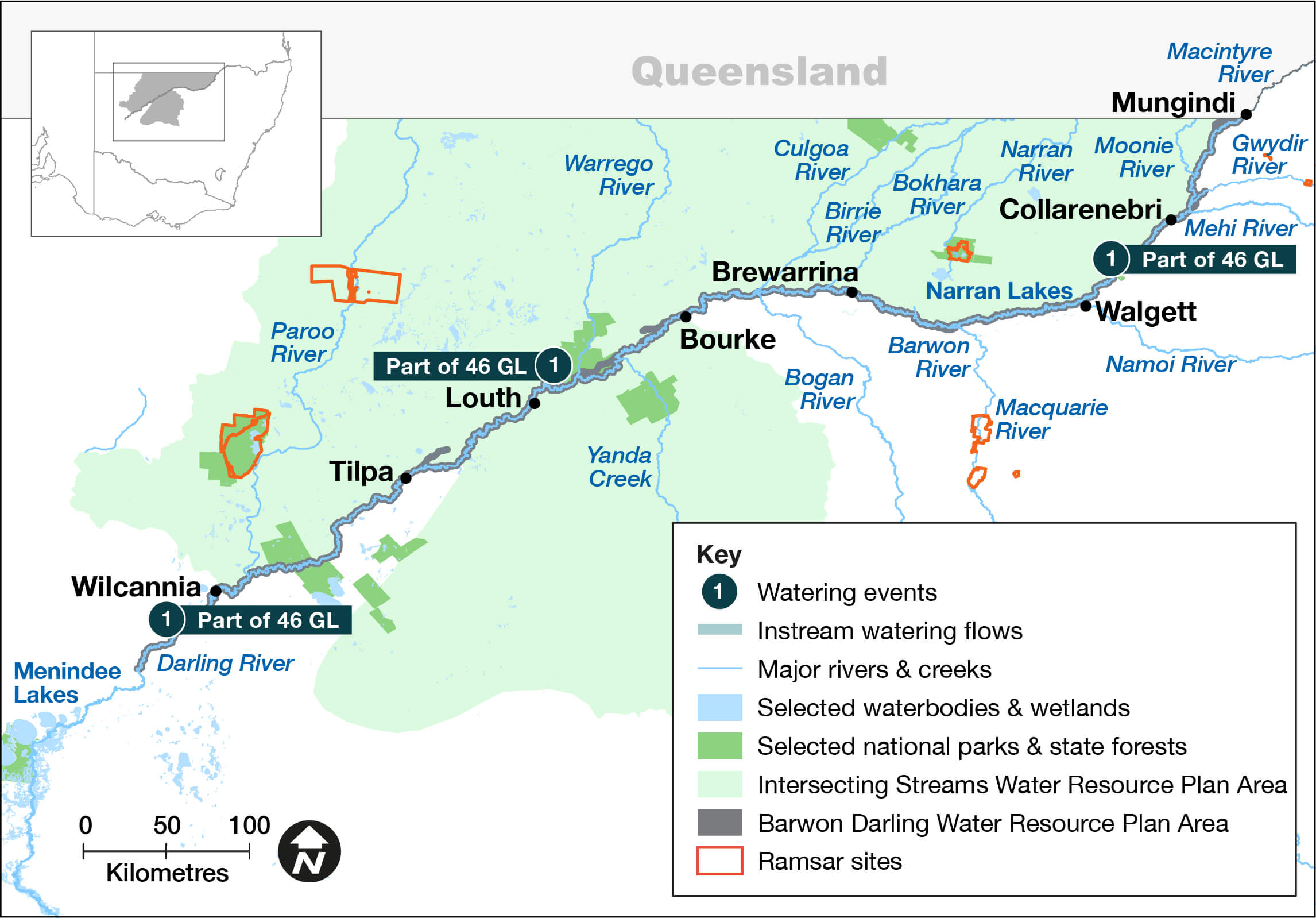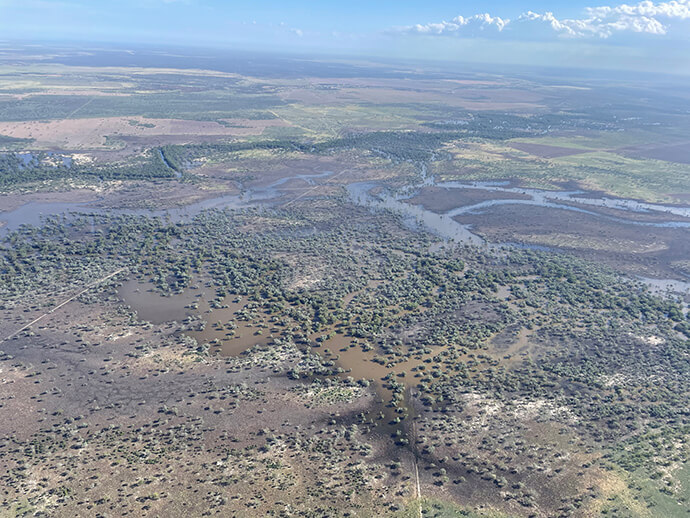Connectivity, floodplain inundation and native fish outcomes were the focus for environmental water managers in the Barwon–Darling Barwaan–Baaka catchment in 2021–22.
Key outcomes
Under wet to very wet conditions, NSW environmental water managers worked with the Commonwealth Environmental Water Holder to protect water for the environment under licenses in the early part of the water year. However, for much of the year natural high flows delivered significant outcomes for the environment which included opportunities for fish movement throughout the system. Outcomes included:
- favourable conditions for native fish recruitment
- connectivity with Menindee Lakes and the Lower Darling Baaka with 4,800 gigalitres passing Wilcannia and an additional 130 gigalitres travelling down the Talyawalka and reconnecting with the Lower Darling Baaka
- periodic inundation of riparian zones and floodplains improving vegetation condition
- flows and inundation to instream and floodplain First Nations priority sites.

Barwon–Darling Barwaan–Baaka catchment map.
Catchment conditions
During the 2021–22 year the Barwon–Darling Barwaan–Baaka catchment and its tributaries experienced La Niña weather conditions resulting in high rainfall and moderate temperatures. Flows were consistently above small fresh levels and extended periods of large fresh and overbank flows also occurred. This negated the need to protect flows in Barwon–Darling Barwaan–Baaka throughout most of the water year.
About the catchment
The Barwon–Darling Barwaan–Baaka catchment is in the north-western part of New South Wales, running approximately 1,600 kilometres down the Barwon–Darling Barwaan–Baaka river system. Located in a semi-arid climatic zone, rainfall is typically low.
Several major river systems flow into the Barwon–Darling Barwaan–Baaka including the Border, Moonie, Gwydir, Namoi, Wambuul (Macquarie), Culgoa, Warrego and Paroo, with the Barwon–Darling Barwaan–Baaka connecting the river systems of the northern Murray Darling Basin with those of the south.
The Barwon–Darling Barwaan–Baaka catchment comprises the unregulated section of the river channel from the junction of the Macintyre and Weir rivers near Mungindi through to Lake Wetherell which is part of the Menindee Lakes system. This includes distributary creeks and a myriad of floodplain wetlands, billabongs and anabranches.
Traditional owners
The Barwon–Darling Barwaan–Baaka catchment is Country to the Euahlayi, Barkindji, Murrawarri, Ngemba, Gomeroi/Kamilaroi and Ngiyampaa First Nations.
Watering aims
The Barwon–Darling Rivers – Water for the Environment: Annual Priorities 2021–22 was developed in response to a dry to moderate resource-availability scenario. Objectives for the use of water for the environment were to:
- increase connection between the Barwon–Darling River and the Lower Darling Baaka downstream of Menindee Lakes
- support remaining stocks of native fish and provide opportunities for them to breed and disperse into refuge habitat
- maintain refuge habitat and food resources to support native fish and mussels as well as turtles, rakali and other aquatic and amphibious fauna
- maintain existing riparian river red gum areas.
With wet to very wet conditions, environmental water managers used an adaptive approach to restore key floodplain and wetland connections and enhance opportunities for plants and animals to breed, move and thrive.
Water delivery
A total of 45,698 megalitres (ML) of water for the environment was protected in the Barwon–Darling Barwaan–Baaka catchment during the 2021–22 watering year using NSW licenses (1,943 ML) and Commonwealth Environmental Water Holder licences (43,755 ML). A further 3,296 ML of held environmental water from the Macquarie River was protected into the Barwon–Darling Barwaan–Baaka under active management. Figures are accurate at the date of publishing, but maybe adjusted.
| Watering event number | Location | Outcomes |
|---|---|---|
| 1 | Barwon–Darling Water Resource Plan Area | Native fish Vegetation Connectivity |
Outcomes
In 2021–22 environmental water managers worked with stakeholders and the community to protect water for the environment to support assets across the catchment such as native fish, riparian and wetland vegetation, and system connectivity.
Both NSW and Commonwealth environmental water licences were used to protect water for the environment to support connectivity along the Barwon-Darling Barwaan–Baaka River. Licences were used in the early part of the water year to protect 1,943 megalitres of NSW and 43,400 megalitres of Commonwealth water.
Protection under NSW licences was primarily between Geera and Brewarrina. Commonwealth licences primarily protected water in the reach between Bourke and Louth. Active management protected flows beyond the river reach to Menindee Lakes. Once the conditions in the catchment and its tributaries were wet, protection using NSW and Commonwealth licences in the Barwon-Darling Barwaan–Baaka was no longer necessary to maintain flows. Conditions remained that way for the rest of the water year.
NSW and Commonwealth water for the environment contributed to meeting First Nations priorities instream, whereas natural flows inundated priority sites on the floodplain and backed up water into tributaries such as Yanda Creek.
Case study: Barwon-Darling floodplain gets a drink
In the summer of 2021–22 natural high flows from the northern tributaries combined to inundate the floodplains of the Barwon–Darling. These flows filled billabongs, anabranches, and wetlands. The event reached many areas that had not been inundated in 10 years. Flows peaked at more than 120,000 megalitres per day at Walgett with significant inflows from the Namoi catchment.
The event saw significant flows break out into Cato Creek near Brewarrina and the Talyawalka Channel near Wilcannia. This provided great benefits to the instream and riparian ecosystems of these areas before re-joining the system downstream and increasing instream productivity in the main channel.
The event provided a recovery opportunity for aquatic and floodplain flora and fauna. Floodplain wetlands and billabongs that received inundation will provide habitat for a number of frogs species to breed during spring, as well as foraging sites for waterbirds. Following the high summer flows, recruitment of flow pulse specialists, golden perch, and generalists, spangled perch, between Bourke and Louth was found in autumn fish surveys funded under the Flow-MER program.
Water quality monitoring by environmental water managers found areas of poor water quality at the front of the flow with low dissolved oxygen from the vast amount of organic matter collected from the floodplain. Despite these areas of low dissolved oxygen water, only 2 minor fish kills were recorded and the event overall had a substantial positive effect on the system that will be felt for years to come.

Aerial view of the Barwon River in flood at Macquarie junction.